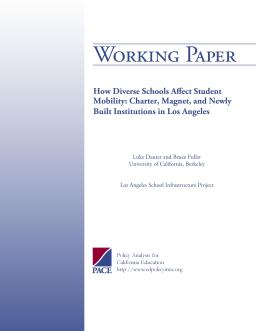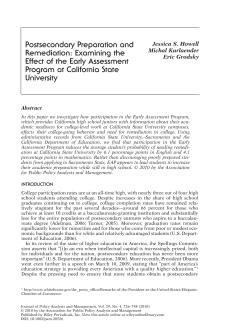Five Years Later
Published
Summary
This report commemorates the fifth anniversary of the Getting Down to Facts project, which sought to provide a thorough and reliable analysis of the critical challenges facing California’s education system as the necessary basis for an informed discussion of policy changes aimed at improving the performance of California schools and students. The report focuses on the four key issues that received emphasis in the Getting Down to Facts studies: governance, finance, personnel, and data systems.
From Governance to Capacity Building
Published
Summary
Education reform efforts in Los Angeles and the US have failed due to the focus on governance and rules. The solution is to invest in capacity building, creating incentives and agency for students and teachers, easing adoption through regulatory relief, and financing those working on new learning models. The goal is to update the century-old model of learning, called Learning 1.0, with a new model, Learning 2.0, that builds an education system around the learning system. This approach is based on research into unconventional learning models.
Charter, Magnet, and Newly Built Campuses in Los Angeles
Published
Summary
This paper examines the impact of pupil mobility in urban districts like Los Angeles, where families are encouraged to switch schools due to the growth of mixed-markets of charter, magnet, and pilot schools. African American and White students are more likely to exit their schools, while overcrowding in low-income Latino neighborhoods leads to higher exit rates. Charter and magnet school students exit less. The district's commitment to relieve overcrowding leads to Latino students moving to newly built schools. The opening of new high schools reduced pupil mobility.
Published
Summary
This report provides policy guidance for new state assessments aligned to Common Core State Standards. It aims to inform the work of the two consortia funded by the U.S. Department of Education in developing the assessments. The report includes three papers addressing issues of computer adaptive assessments, assessment of English learners, and assessing science. The authors' vision of new assessments goes beyond the horizon of current practice and emphasizes the need to use new technologies to provide useful and timely information to students and teachers.
Clearing Away the Smoke and Mirrors
Published
Summary
This brief examines the strengths and weaknesses of value-added measures, which are useful for separating out school influences from other factors when evaluating teacher and school performance. Although value-added assessments give a summative picture of teacher performance, they do not provide guidance on how to improve. The author explores best uses and practices for value-added measures and discusses the limitations of attainment measures in evaluating school performance. The "Cardinal Rule of Accountability" is to hold people accountable for what they can control.
Examining the Effect of the Early Assessment Program at California State University
Published
Summary
This study analyzes the impact of the Early Assessment Program (EAP) on the college-going behavior and remediation needs of California high school juniors. Results show that EAP participation reduces the need for remediation at California State Universities by 6.1 percentage points in English and 4.1 percentage points in mathematics. The program does not discourage poorly prepared students from applying to college but rather encourages them to increase their academic preparation in high school.





